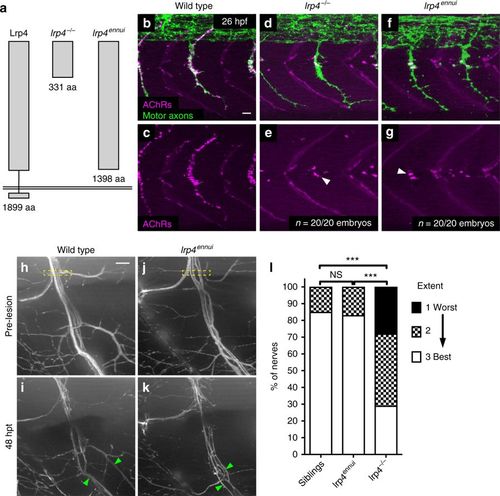
A truncated version of Lrp4 promotes nerve regeneration. a Schematic of lrp4 alleles and their protein structures: wild-type full-length Lrp4 is shown at far left (1899 amino acids). lrp4?/? allele encodes a protein of 331 amino acids. lrp4ennui encodes a protein of 1398 amino acids that is predicted to contain almost the entire ectodomain but lack the transmembrane and intracellular domains. b?g Lateral views of wild type, lrp4?/?, and lrp4ennui embryos at the stage when en passant neuromuscular synapses form (26 hpf) stained for acetylcholine receptors (AChRs; magenta) and motor axons (green). Scale bar is 10?Ám. b?c In wild-type embryos, AChR clusters assemble beneath the entire motor axon. d?g In lrp4 mutant and lrp4ennui embryos there is a strong reduction in AChR clustering beneath the motor axon, with only a few AChR clusters observed (white arrowheads); n?=?20 out of 20 embryos examined for each genotype. h Lateral view of pre-transection wild-type motor nerve labeled with GFP at 5 dpf. Transection site is marked by yellow box. Scale bar is 10?Ám. i Forty-eight hours post transection in wild-type larvae, multiple fascicles have regenerated ventrally (marked by green arrowheads). j Lateral view of pre-transection motor nerve in lrp4ennui labeled with GFP at 5 dpf. Transection site marked by yellow box. k Forty-eight hours post transection in lrp4ennui, multiple fascicles have regenerated ventrally (green arrowheads). l Quantification of nerve regeneration in wild-type larvae (n?=?26 nerves from 13 larvae), lrp4 mutants (n?=?28 nerves from 13 larvae) and lrp4ennui (n?=?24 nerves from 9 larvae) at 48?h post transection. lrp4ennui nerves regenerate to the same extent as wild-type sibling nerves (wild-type siblings ?best? regeneration?=?85% of nerves; lrp4ennui ?best? regeneration?=?83% of nerves; ?2-test p?=?0.1672, ?2?=?3.577, df?=?2)
|

